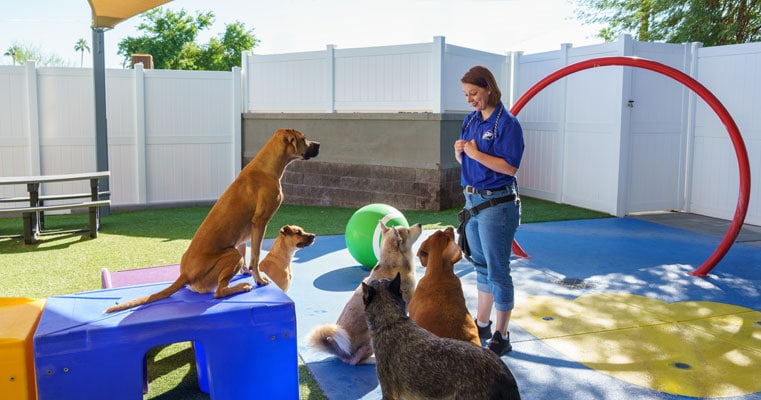Effective Puppy Training to Help Your Pet Grow into a Well-Behaved Adult Dog
Effective Puppy Training to Help Your Pet Grow into a Well-Behaved Adult Dog
Blog Article
Transform Your Pet dog's Behavior With Proven Training Approaches
Transforming your dog's actions needs a nuanced understanding of their individual qualities and requirements, as well as the application of tested training techniques. By using positive reinforcement and acknowledging essential add their body language, you can properly resolve usual behavior issues such as too much barking or jumping. Uniformity in your training strategy not only enhances obedience yet also promotes a deeper bond of trust and respect between you and your pet. However, the course to successful makeover might provide unforeseen challenges that warrant more expedition.

Understanding Canine Habits
Understanding dog habits is essential for effective training and communication in between humans and their canine companions. Canines, as social pets, display a variety of habits influenced by genetics, atmosphere, and experiences. Recognizing these behaviors helps owners tailor their training approaches to meet the certain demands of their pets.
Trick aspects of pet dog actions consist of body language, articulations, and social interactions. In addition, socializing plays an important function in shaping habits; pet dogs that communicate positively with other pets and different individuals are normally extra adaptable and well-adjusted.
Moreover, recognizing stress signals-- such as evasion, pacing, or panting actions-- can stop rise right into a lot more significant problems. Proprietors who are in harmony with their pet dog's actions can produce a safe and nurturing setting, promoting count on and boosting the training process. Eventually, a deep understanding of canine habits lays the structure for a harmonious partnership and reliable training results, making sure both pets and their owners grow with each other.
Favorable Support Strategies
Positive reinforcement strategies are extensively acknowledged as one of the most effective approaches for training pets, cultivating a positive discovering setting. This method entails fulfilling wanted actions with treats, praise, or play, therefore urging the dog to repeat those actions (Dog training). Unlike vindictive techniques, positive reinforcement constructs depend on and enhances the bond between the pet and the trainer
To execute positive reinforcement effectively, timing is vital. Rewards must be provided immediately complying with the wanted actions to aid the dog make the connection. Uniformity is likewise essential; using the very same commands and rewards aids the pet understand what is anticipated. Additionally, varying the benefits can keep the pet involved. Rotating between deals with, toys, and spoken appreciation can preserve interest and motivation.
It is essential to note that favorable reinforcement is not regarding bribery; instead, it is concerning enhancing good habits. With time, as the dog learns to connect details actions with favorable outcomes, the frequency of rewards can be gradually lowered, transitioning to verbal appreciation or recurring incentives. This method not only encourages obedience but likewise promotes a delighted and confident canine, making training a much more satisfying experience for both events entailed.
Resolving Usual Problems
Addressing common problems throughout dog training is crucial for ensuring a effective and harmonious partnership in between the pet and its proprietor. Numerous pet dog proprietors encounter behavioral difficulties, such as too much barking, jumping, and leash drawing. Understanding the origin triggers of these behaviors is important for efficient training.
Excessive barking may come from dullness, anxiety, or a lack of socialization. To reduce this, supply enough workout, psychological excitement, and opportunities for social interaction with both humans and various other pet dogs. Jumping can commonly signify enjoyment or a need for attention. Educating the pet to sit upon welcoming can redirect this habits positively.
Leash drawing is one more common concern, frequently resulting from a canine's passion to check out. Making use of proper leash handling techniques, integrated with training methods that encourage loose-leash walking, can significantly enhance this habits.
Furthermore, problems like source guarding or separation anxiousness call for customized strategies. Gradual desensitization and counter-conditioning can be effective in attending to these obstacles. By identifying and proactively handling these common problems, dog proprietors can cultivate an extra pleasurable training experience and strengthen the bond with their canine friends.
Uniformity in Training
Uniformity is a cornerstone of efficient pet training, as it develops a clear structure for the pet to understand behaviors and expectations. When benefits, hints, and commands are applied evenly, canines can quicker realize what is required of them. Irregular training can cause confusion, resulting in unwanted habits that annoy both the canine and the instructor.
To accomplish uniformity, it is vital that all participants of the family follow the same training techniques. For instance, utilizing the exact same spoken hints and hand signals makes sure that the canine gets consistent messages. Furthermore, the timing of improvements and benefits should be consistent; immediate support boosts the possibility that the dog will link the behavior with the result.
In addition, developing a regimen can better boost uniformity. Regular session, coupled with organized routines for feeding, walking, and play, help pets anticipate and comprehend their setting, making them extra receptive to training. Ultimately, uniformity fosters a feeling of safety and trust fund, encouraging pet dogs to discover a anchor lot more effectively. By committing to an organized method, fitness instructors can advertise favorable habits modifications and cultivate a courteous friend.
Building a Solid Bond
Just how can fostering a solid bond between a pet dog and its proprietor enhance the training experience? A strong connection developed click to investigate on trust and respect serves as the foundation for reliable training. When a dog really feels safe in its link with its proprietor, it is most likely to display favorable habits and be responsive to finding out. This bond urges the pet to engage fully in training sessions, as it watches the owner as a resource of support and support.

Furthermore, a well-established connection can lower anxiety and behavior concerns, as dogs are much less likely to act out when they really feel recognized and looked after. Consequently, prioritizing the development of a solid bond not only enhances the training experience however also adds to a happier and extra well-adjusted pet dog. Ultimately, the journey of training changes into a collaborative partnership, resulting in lasting behavior renovations.
Conclusion

Proprietors who are attuned to their pet's habits can produce a caring and secure environment, promoting count on and enhancing the training process. Eventually, a deep understanding of canine actions lays the structure for a harmonious partnership and effective training results, ensuring both canines and their owners prosper together.
Attending to usual problems during pet dog training is important for ensuring a effective and unified partnership between the pet dog and its proprietor (Dog training).Consistency is a foundation of effective pet training, as it establishes a clear structure for the pet to recognize actions and expectations.In final thought, transforming a pet dog's habits through confirmed training methods calls for an understanding of canine behavior, the application of positive reinforcement techniques, and a focus on consistency
Report this page